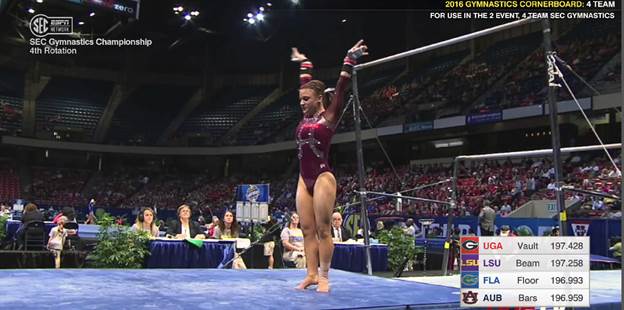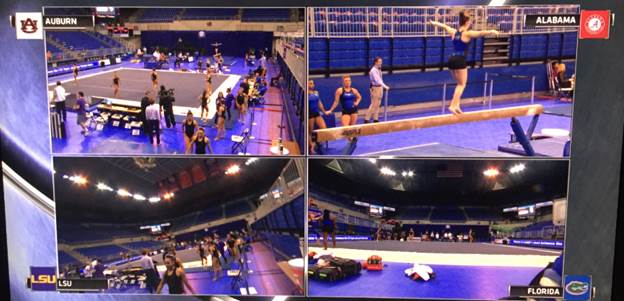ESPN Breaks Down Live Barrier at SEC, NCAA Gymnastics Championships
Scoring interface, graphics, live apparatus streams provide robust coverage
Story Highlights
Gymnastics is one of those sports — much like golf — for which a live broadcast is never really live for a majority of the show. That is, until now.
Last weekend, ESPN and the SEC Network brought unprecedented live coverage to the SEC Gymnastics Championships with the goal of bringing the same to the NCAA Championships set to air April 15-16.
“This is big, so big,” says Meg Aronowitz, coordinating producer, ESPN. “I think what we’re trying to do is extremely ambitious. Those in the competitive-gymnastics world are thrilled with what we are attempting to do. They really feel like it’s a huge step forward for the sport of gymnastics.”

At the SEC Gymnastics Championship last Saturday, ESPN debuted a revamped graphics package that interfaced with a newly designed live scoring system.
ESPN provided live linear television coverage of Saturday’s SEC Championship quad meet, swinging around multiple apparatuses and using an advanced scoring interface and graphics design to keep fans updated. In addition, on ESPN3, viewers could live-stream channels focused on individual apparatuses.
ESPN is no stranger to gymnastics, having carried the NCAA Championships on a short tape delay in the past. The network has also carried the SEC Gymnastics Championship since 2010. However, last Saturday’s afternoon and evening sessions on ESPNU and SEC Network, respectively, marked the first time the tournament was live in its entirety on national television. It’s truly a milestone moment for the sport, but it presented a new set of production challenges in offering fans the best viewing experience: most notably, timing and scoring.
Setting the Live Pace
The chief reason gymnastics is not traditionally covered live that multiple competitions occur simultaneously. The action can be fast and furious and difficult for producers to put into context. Simply keeping the production treading water can be a challenge.
“If everybody is not doing their job and on the same page, we are going to get behind quickly,” says Aronowitz, “and it’s going to show in the coverage.”
ESPN’s crew is focused on being live. That means double-box displays, quad-box displays, and fewer replays.

On both linear and digital platforms, ESPN used a quad box to keep viewers updated on where their favorite teams were currently performing.
“Our goal is to get as much live as we possibly can,” says Aronowitz. “Every time we go to a replay on the bars, we are missing someone live on the beam that we want to be able to see. We want to be in the moment as much as possible.”
ESPN’s linear and digital goals laid a foundation for the camera choices. With fewer replays, there’s only one super-slo-mo. Nine cameras (three hard, six handheld — all with wide-angle lenses) are set up around the arena to provide full coverage and to ensure that every apparatus is covered for the ESPN3 feeds. Five Marshall POV cameras and a jib provide additional coverage.
Graphics and Scoring Tell the Tale
ESPN and SEC Network have been cutting their live-gymnastics teeth this year with coverage throughout the regular season, but those have been dual meets. Quad and, in the case of the NCAA Championships, “Super Six” meets are a whole other beast. As a result, ESPN’s technical talent had to completely re-engineer and rewrite coding on an internal scoring system.
“People that watch gymnastics for the first time get really confused on how scores are tabulated, why scores are dropped, what’s happening,” says Aronowitz. “Sometimes, you’re watching a gymnastics meet, and you think ‘Florida is the clear winner,’ and then it comes down to a tenth of a point at the end of the fourth rotation, and you don’t understand the math. It’s really important to make sure that we’re educating [viewers] and keeping them updated on what’s happening from a scoring standpoint.”
Last weekend marked the first time ESPN rolled out the scoring system at a quad meet. The NCAA event will be the first time it will test itself live in a Super Six environment. The scoring system also needs to interface with a new Vizrt graphics engine, which offers a new-look graphics package that aligns the Gymnastics Championships with other marquee college championships events, including football and basketball.
All-Around Surround
Similar to last week’s coverage of the NCAA Wrestling Championships, ESPN’s multiplatform coverage is intended to offer viewers the opportunity to pick and choose what they watch throughout the day.
ESPN3 offered five additional channels: four feeds, each focused on a single apparatus, and a fifth channel with a quad box (called the “All-Around”) of all four channels displaying team logos to identify which rotation the channel is currently on. The goal is to let viewers easily identify their team and switch to that channel. It’s a tactic that was used on the linear side as well.
The individual feeds offer effects mics only (no announcers) and a scoreboard graphic so that viewers can stay up- to-date on the leaders on the particular apparatus.
“It’s the epitome of a second-screen experience, because you can follow your team in your hand and the full broadcast on your TV and not miss a beat. We’re really excited about it.”
All five streaming options, as well as the simulcast of the television coverage, were available through the ESPN app and WatchESPN on the SEC Network+ channels.
